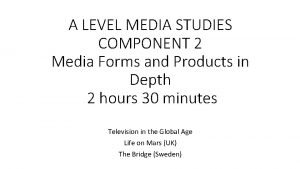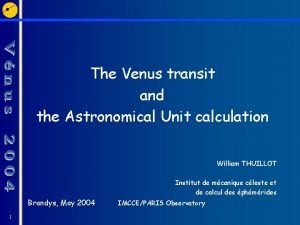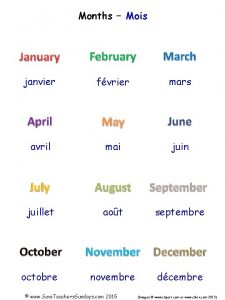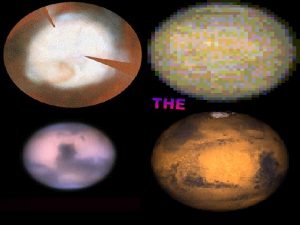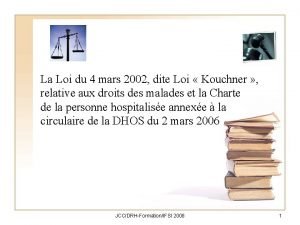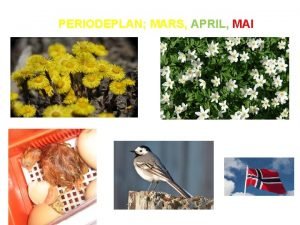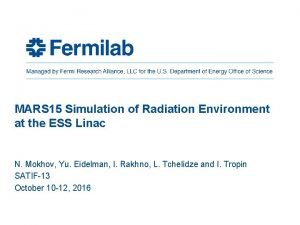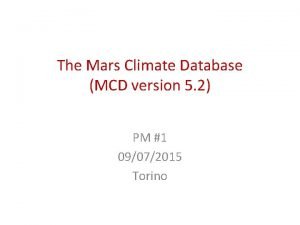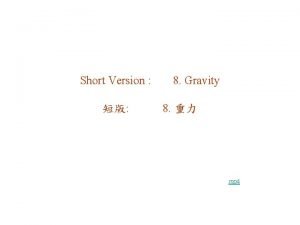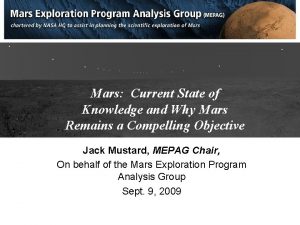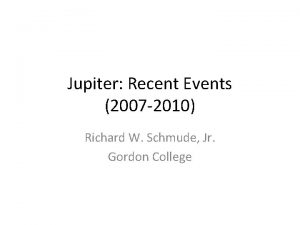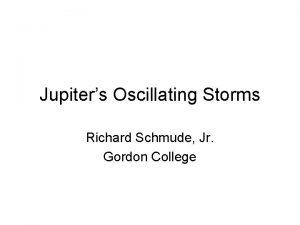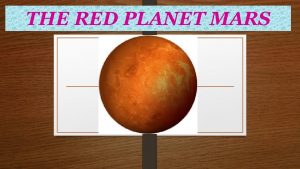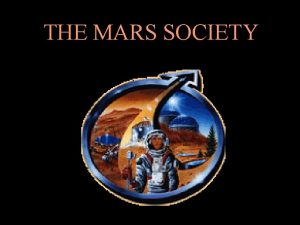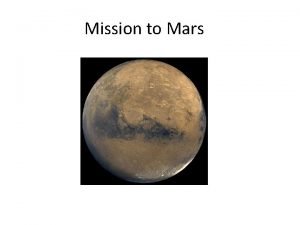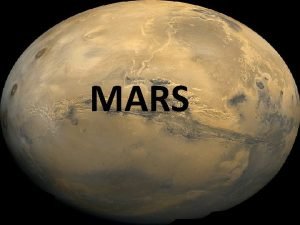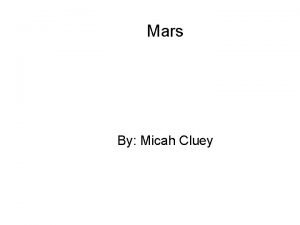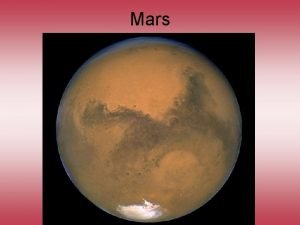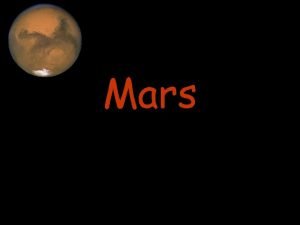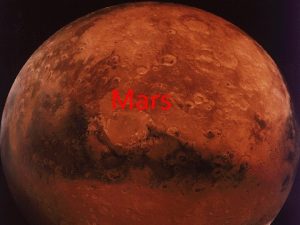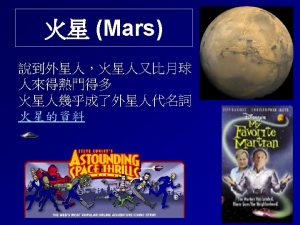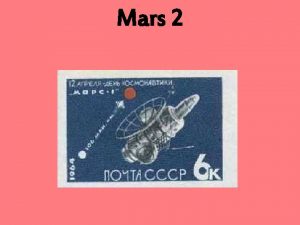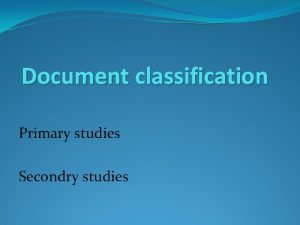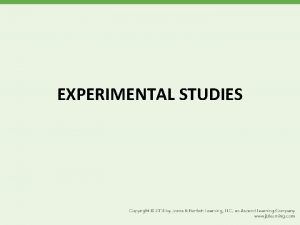Recent Studies of Mars 20132014 Richard W Schmude





































- Slides: 37

Recent Studies of Mars: 20132014 Richard W. Schmude, Jr. Gordon State College Barnesville, GA

Overview • Purpose of work • North Polar Cap (NPC) • Hellas • Brightness measurements

Purpose • NPC interannual variability • Hellas variability – Time of day – Year – season • Brightness (visible & Near infrared)

Hubble Image Processed by P. James, T. Clancy, S. Lee and NASA

Introduction: Ls Ls range 0 – 90° 90 – 180° 180 – 270° 270 – 0° Season (N. hemisphere) Spring Summer Fall Winter

Voting Questions • Do not talk to anyone until after 1 st vote • After 1 st vote – Talk to someone that you disagree with – Convince him/her that you are right – Listen to your partner

Voting Question • If Ls = 135° it is ______ in the northern hemisphere. a. late spring c. early summer b. mid spring d. mid summer

Voting Question Ls = 50° is similar to _______ in the USA. a. February c. October b. June d. May

Method and Materials • Win. Jupos – Name an image • 2014 -07 -12 -1320 -name & other info. – Load an image – Software computes longitude & latitude

Polar Cap Measurement Goal: get all longitudes

NPC: Mean latitude

Hellas measurements • Northern border measured – Every 5° of longitude – 270° W to 320° W – Red light images used – Mean values computed for each 5° of longitude

Why red light? green-left & red-right

Results: NPC in 2013 – 2014

Interannual variability • Spring NPC – Mean latitudes (all longitudes) considered – Wilcoxon Signed Rank Test • 90% confidence level • As few as five values • Non-parametric test

Data sets • MGS: 2000, 2002, 2006*, 2007 -08* • Schmude: 2009 -10, 2011 -12, 2013 -14 • Individual latitudes are not reported

Results Year 2000 2002 2006 2007 -08 2009 -10 2011 -12 2013 -14 D mean latitude --0. 9° ~0. 2° ~0. 6° 0. 8° 0. 3° 0. 0° Comparison to 2000 The standard Larger Probably the same Probably smaller Larger Same

Voting Question At Ls = 50°, the temperatures are _____ in the southern hemisphere of Mars. a. rising b. falling

Hellas: white layer • Northern border – Clouds or frost? – Growth during fall? – Changes from morning to afternoon? – Interannual differences?

Hellas: white layer

Hellas: changes in Northern border • Wilcoxon Signed Rank Test – Mid fall (1995) and late fall – early winter (2014) – Morning afternoon (2014) – 2012 and 2014 (similar seasons)

Statistical results: Hellas • There is no statistical difference (90% conf. ) – Mid fall and late fall/early winter – Morning and afternoon – 2012 and 2014 (similar seasons)

Brightness Measurements • Purpose – Long-term changes – Water reservoirs – Dust storms – Brightness model of planet

Brightness in Magnitudes • Zero magnitude = a flux of light • As magnitude drops, brightness increases

Electromagnetic Radiation • • Electric wave Magnetic wave Velocity = 186, 000 miles/hour (vacuum) Wavelength (length of one wave)

Electromagnetic radiation Wavelength and color Filter V R J H Wavelength 540 nm 700 nm 1250 nm 1650 nm Color green red none

Previous work • Schmude measured B, V, R and I brightness of Mars from 1991 to 2014 • Mallama (2007) summarizes work up to 2005. • Almost no work done for J and H filters

Near Infrared light

Voting question Please rank the objects from highest to lowest magnitude. a. Sun, full Moon, Venus b. Sun, Venus, full Moon c. Full Moon, Venus, Sun d. Venus, full Moon, Sun

Materials • • SSP-4 photometer Celestron CG-4 mount 0. 09 m Maksutov telescope Extension cord (requires AC power)

Experimental set-up

Method of brightness measurement • Sky brightness and then comparison star • Sky brightness and then Mars • Repeat 2 ½ more times • Compute Mars’ magnitude • Make corrections

Normalized Magnitude J(1, 0) and H(1, 0) • Mars is 1 au from Earth and Sun • Sunlight reflects directly back to observer (zero phase angle)

Results: Albedo

Light curve J filter

Light curve H filter

Conclusions • NPC may undergo small changes from one year to the next • Hellas white area: No change with respect to diurnal, seasonal or year to year cycles • Mars’ albedo does not rise in near infrared • Mars brightens as it rotates in the J & H filters
 Life on mars audience media studies
Life on mars audience media studies Richard iii pursuit of power
Richard iii pursuit of power Paradigm shift from women studies to gender studies
Paradigm shift from women studies to gender studies Recent advances in ceramics
Recent advances in ceramics A friend emails you the results
A friend emails you the results Foreign trade
Foreign trade Recent trends in mis
Recent trends in mis Myips.schoology.com
Myips.schoology.com Recent developments in ict
Recent developments in ict Recent news in passive voice
Recent news in passive voice In recent years evidence has been collected
In recent years evidence has been collected Comait
Comait Geotaphonomy
Geotaphonomy Recent developments in object detection
Recent developments in object detection Http drive google com
Http drive google com Current trends in project management
Current trends in project management After a skydiving accident laurie
After a skydiving accident laurie Many recent college graduates have faced
Many recent college graduates have faced Can backdated udin be generated
Can backdated udin be generated Recent demographic changes in the uk
Recent demographic changes in the uk Recent trends in ic engine
Recent trends in ic engine Cassini mars
Cassini mars Janvier fevrier mars avril months in french
Janvier fevrier mars avril months in french Destination mars
Destination mars Bruno mars plastic surgery
Bruno mars plastic surgery Izzó gázgömb
Izzó gázgömb Mars petcare columbia sc
Mars petcare columbia sc Planet mars pictures
Planet mars pictures Das mars
Das mars Loi du 4 mars 2002
Loi du 4 mars 2002 Mars model of individual behaviour
Mars model of individual behaviour Vårmåneder
Vårmåneder Mars marketing simulation
Mars marketing simulation Mars climate database
Mars climate database Distant retrograde orbit
Distant retrograde orbit Knowledge about mars
Knowledge about mars Invasion from mars characters
Invasion from mars characters Brunl mars
Brunl mars
